Reverse Engineering Dockerfiles for Azure Arc-Enabled Data Services
Enterprise Organizations looking to onboard Azure Arc-Enabled Data Services onto their Kubernetes Clusters may have several reasons for wishing to deep-dive and gain access to the Dockerfiles that were used to build the Containers. While vendor tools such as Aquasec serves to scan the containers once the environment is productionalized, the Dockerfile can provide a great bird's eye view into the inner workings of the Containers without much up front effort.
This article showcases a technique to generate Dockerfiles for a Container, without access to the source code that was originally used to perform docker build. This technique takes advantage of extracting information out of the Docker.sock UNIX socket, using Community built tools.
Pods and Containers for Arc-Enabled Data Services
Arc-Enabled Data Services deploys a list of purpose-driven Kubernetes Pods onto a Kubernetes Cluster - purposes such as serving the Operator Pattern for the Custom Resources that make up the Arc-enabled Data Services (i.e. SQL MI, PostgreSQL and other adjacent CRDs).
For example, if we were to go through any Arc Jumpstart Scenarios to deploy a fresh Kubernetes Cluster on a Cloud vendor of choice, onboard it with Azure Arc, then deploy an Arc Data Controller, SQL MI and PostgreSQL Pods, here is a visual representation of the list of Data Services Pods deployed on our Kubernetes Cluster end-to-end:
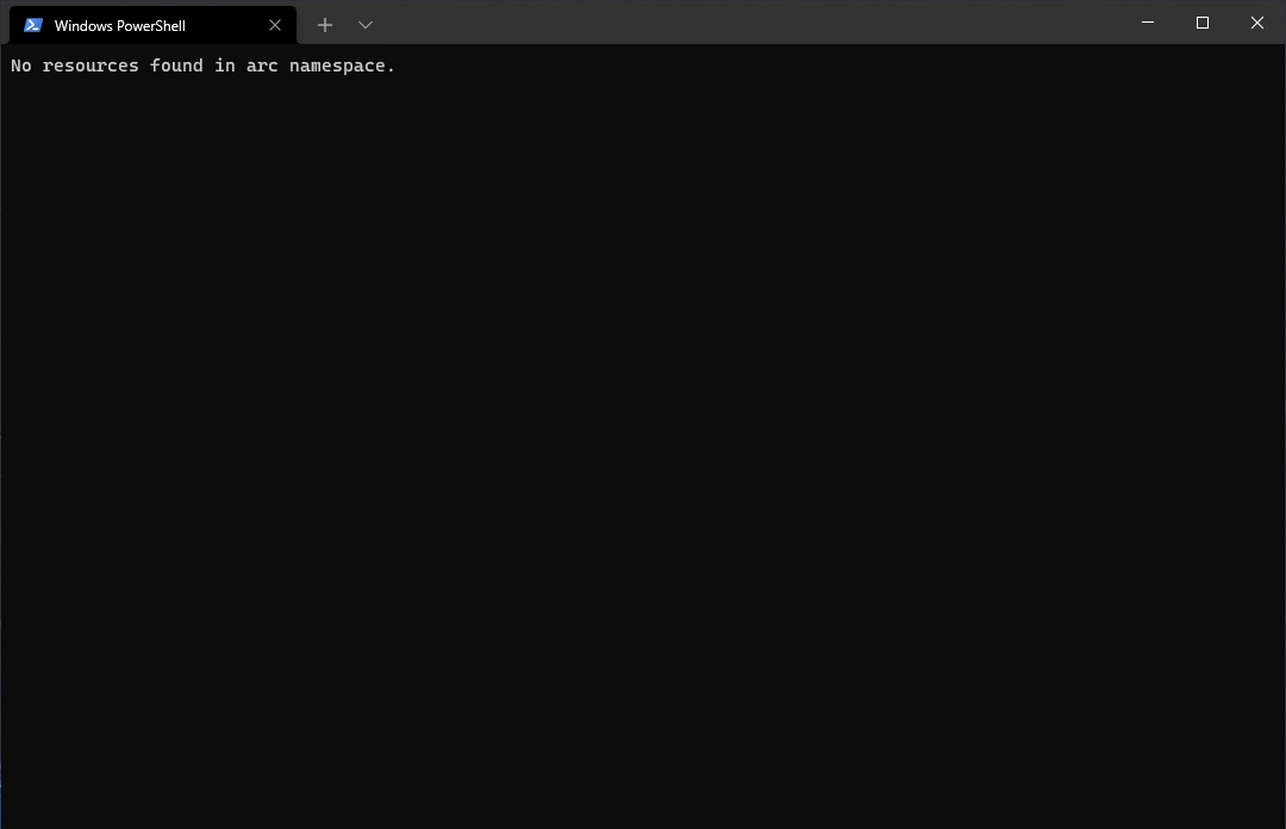
The in-order sequence of Pods (in this case deployed to the arc namespace above) can be pulled out via:
kubectl get pods -n arc --sort-by=.metadata.creationTimestamp
NAME READY STATUS RESTARTS AGE
bootstrapper-b96sb 1/1 Running 0 20m
control-vx6q8 2/2 Running 0 17m
controldb-0 2/2 Running 0 16m
metricsdc-5ntxl 1/1 Running 0 15m
metricsdc-cfd92 1/1 Running 0 15m
metricsui-dn7rt 1/1 Running 0 15m
logsdb-0 2/2 Running 0 15m
metricsdb-0 1/1 Running 0 15m
logsui-whlbf 2/2 Running 0 13m
jumpstart-sql-0 3/3 Running 0 13m
jumpstartpsc0-0 3/3 Running 0 8m36s
jumpstartpsw0-0 3/3 Running 0 8m36sAt a high-level:
bootstrapper-abcdeis the first Pod that gets spun up (among other things, it introduces the Data Service speciific CRDs into our K8s cluster)control-abcdeandcontroldb-0- which makes up the "Data Controller" that serves the Operator Pattern for Arc Custom Resources (e.g. SQL MI, PostgreSQL)metrics...andlogs..- UI (Kibana, Grafana) and DB (Elastic, Influx) serving the Monitoring Stack (which is a standalone CRD)jumpstart-sql-0is a SQL Managed Instancejumpstartpsc0-0andjumpstartpsw0-0is a PostgreSQL Citus Coordinator and Worker Pod respectively
We can ask Kubernetes to give us the list of Container Images that make up each of these Pods via:
kubectl get pods -n arc -o=jsonpath="{range .items[*]}{'\n'}{.metadata.name}{':\t'}{range .spec.containers[*]}{.image}{', '}{end}{end}"
NAME IMAGE
bootstrapper-tk9hs: mcr.microsoft.com/arcdata/arc-bootstrapper:public-preview-jun-2021,
control-sj59j: mcr.microsoft.com/arcdata/arc-monitor-fluentbit:public-preview-jun-2021, mcr.microsoft.com/arcdata/arc-controller:public-preview-jun-2021,
controldb-0: mcr.microsoft.com/arcdata/arc-monitor-fluentbit:public-preview-jun-2021, mcr.microsoft.com/arcdata/arc-server-controller:public-preview-jun-2021,
jumpstart-sql-0: mcr.microsoft.com/arcdata/arc-sqlmi:public-preview-jun-2021, mcr.microsoft.com/arcdata/arc-monitor-collectd:public-preview-jun-2021, mcr.microsoft.com/arcdata/arc-monitor-fluentbit:public-preview-jun-2021,
jumpstartpsc0-0: mcr.microsoft.com/arcdata/arc-postgres-12:public-preview-jun-2021, mcr.microsoft.com/arcdata/arc-monitor-telegraf:public-preview-jun-2021, mcr.microsoft.com/arcdata/arc-monitor-fluentbit:public-preview-jun-2021,
jumpstartpsw0-0: mcr.microsoft.com/arcdata/arc-postgres-12:public-preview-jun-2021, mcr.microsoft.com/arcdata/arc-monitor-telegraf:public-preview-jun-2021, mcr.microsoft.com/arcdata/arc-monitor-fluentbit:public-preview-jun-2021,
logsdb-0: mcr.microsoft.com/arcdata/arc-monitor-elasticsearch:public-preview-jun-2021, mcr.microsoft.com/arcdata/arc-service-proxy:public-preview-jun-2021,
logsui-2ncr2: mcr.microsoft.com/arcdata/arc-monitor-kibana:public-preview-jun-2021, mcr.microsoft.com/arcdata/arc-service-proxy:public-preview-jun-2021,
metricsdb-0: mcr.microsoft.com/arcdata/arc-monitor-influxdb:public-preview-jun-2021,
metricsdc-8kdh6: mcr.microsoft.com/arcdata/arc-monitor-telegraf:public-preview-jun-2021,
metricsdc-n2vfd: mcr.microsoft.com/arcdata/arc-monitor-telegraf:public-preview-jun-2021,
metricsui-h9p7k: mcr.microsoft.com/arcdata/arc-monitor-grafana:public-preview-jun-2021, mcr.microsoft.com/azuremonitor/containerinsights/ciprod:ciprod03262021We note that all of these images are getting sourced from Microsoft Container Registry (MCR) - but Customers have the flexibility to push these images into their private registry first using the techniques illustrated in this script. From there, Customers can choose to scan these images using Container Scanners etc, before onboarding onto their Kubernetes Clusters.
POC: Reverse Engineering a simple Container
Microsoft recently introduced the new Operating System CBL-Mariner (Common Base Linux) - which is used across Azure Stack HCI, AKS, IoT Edge and WSL. Source code is available in Github here - meaning anyone can transparently build an application on top of the Mariner OS - as I'll be demonstrating.
Here we have a simple Dockerfile that uses the Mariner OS (from this quick repo):
FROM cblmariner.azurecr.io/base/core:1.0 AS runtime
# Copy sample config files.
COPY config/wsl.conf /etc/wsl.conf
COPY config/weston.ini /home/wslg/.config/weston.ini
COPY config/local.conf /etc/fonts/local.conf
# Copy sample icon file.
COPY resources/linux.png /usr/share/icons/wsl/linux.pngWe can do a docker build > tag > push to push the Container image up to a registry, which I've done to Docker Hub here.
Now, to reverse engineer this image's Dockerfile without access to the repo, we can leverage Whaler - one of a handful of tools available in the Community to reverse engineer docker images. Whaler is conveniently made available inside the container image alpine/dfimage on Dockerhub.
We can invoke Whaler against any Container using 2 lines of code:
# Defines an alias command that we're going to reuse
alias dfimage="docker run -v /var/run/docker.sock:/var/run/docker.sock --rm alpine/dfimage"
# Call against container of choice and pull out the Dockerfile
dfimage -sV=1.36 mdrrakiburrahman/cbl-mariner-test:0.1.0 | grep -Pzo '.*Dockerfile(.*\n)*'So if we were to run this command on any local machine that has Docker CLI available against the earlier Mariner image pushed to Docherhub, this is what we would see:

As we can see, it's identical to the Dockerfile used to initially generate the image. We can use this technique to reverse engineer any other Container Image we like as well - such as the SQL MI pod that gets deployed for Azure Arc.
Reverse Engineering SQL MI Container
Dockerfile
As we noted in our table earlier, the SQL MI "Pod" is actually made up of 3 containers: arc-sqlmi, collectd and fluentbit. We are interested in arc-sqlmi - which contains the binaries that make up the core SQL Server Engine. We can leverage our command from earlier to pull out the Dockerfile as follows:
dfimage -sV=1.36 mcr.microsoft.com/arcdata/arc-sqlmi:public-preview-jun-2021 | grep -Pzo '.*Dockerfile(.*\n)*'The command above returns something like this:
Dockerfile:
CMD ["bash"]
COPY file:b2f70b16162a0a54897a04f7f3760a6520ad364229dd1b3971215c6d6aaceba2 in /tmp/apt-get.sh
tmp/
tmp/apt-get.sh
RUN /tmp/apt-get.sh
MAINTAINER dpgswdist@microsoft.com
LABEL vendor=Microsoft com.microsoft.product=Microsoft SQL Server com.microsoft.version=15.0.2148.137
EXPOSE 1433
ENV BUILD_VERSION=15.0.2148.137
COPY dir:ca83eb371a12b4064707ea535c5d3878cab3a8263270b1a7316001a531637bc4 in /
opt/
opt/mssql/
opt/mssql/bin/
opt/mssql/bin/adutil
opt/mssql/bin/attach-debugger.sh
opt/mssql/bin/compress-dump.sh
opt/mssql/bin/crash-support-functions.sh
.
.
(Ommitted for brevity)
.
.
opt/supervisor/conf.d/provisioner.conf
tmp/
tmp/install.sh
RUN /tmp/install.sh
CMD ["/opt/agent/bin/agent"]
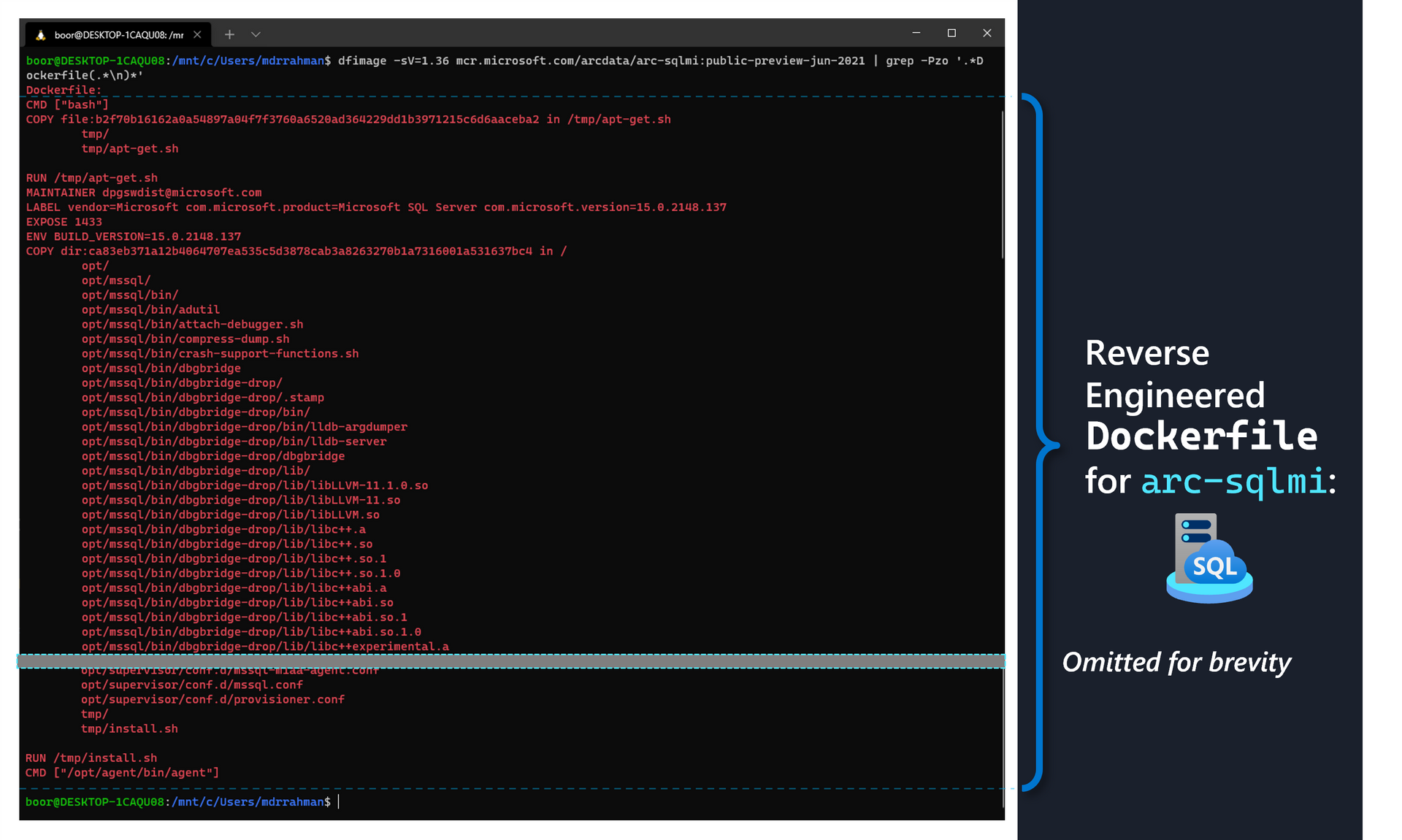
Container binaries
If we like, we can even go a step further from the Dockerfile, and use kubectl cp to recursively pull out the actual files/binaries that make up the Pod - a subset of which were copied into the Container as part of the Dockerfile build above:
# arc-sqlmi
cd "C:\Temp\code_dump\jumpstart-sql-0\arc-sqlmi"
kubectl cp arc/jumpstart-sql-0:/ . -c arc-sqlmi
# collectd
cd "C:\Temp\code_dump\jumpstart-sql-0\collectd"
kubectl cp arc/jumpstart-sql-0:/ . -c collectd
# fluentbit
cd "C:\Temp\code_dump\jumpstart-sql-0\fluentbit"
kubectl cp arc/jumpstart-sql-0:/ . -c fluentbitAnd we see the files from all 3 Containers get copied to our Local Windows Drive:
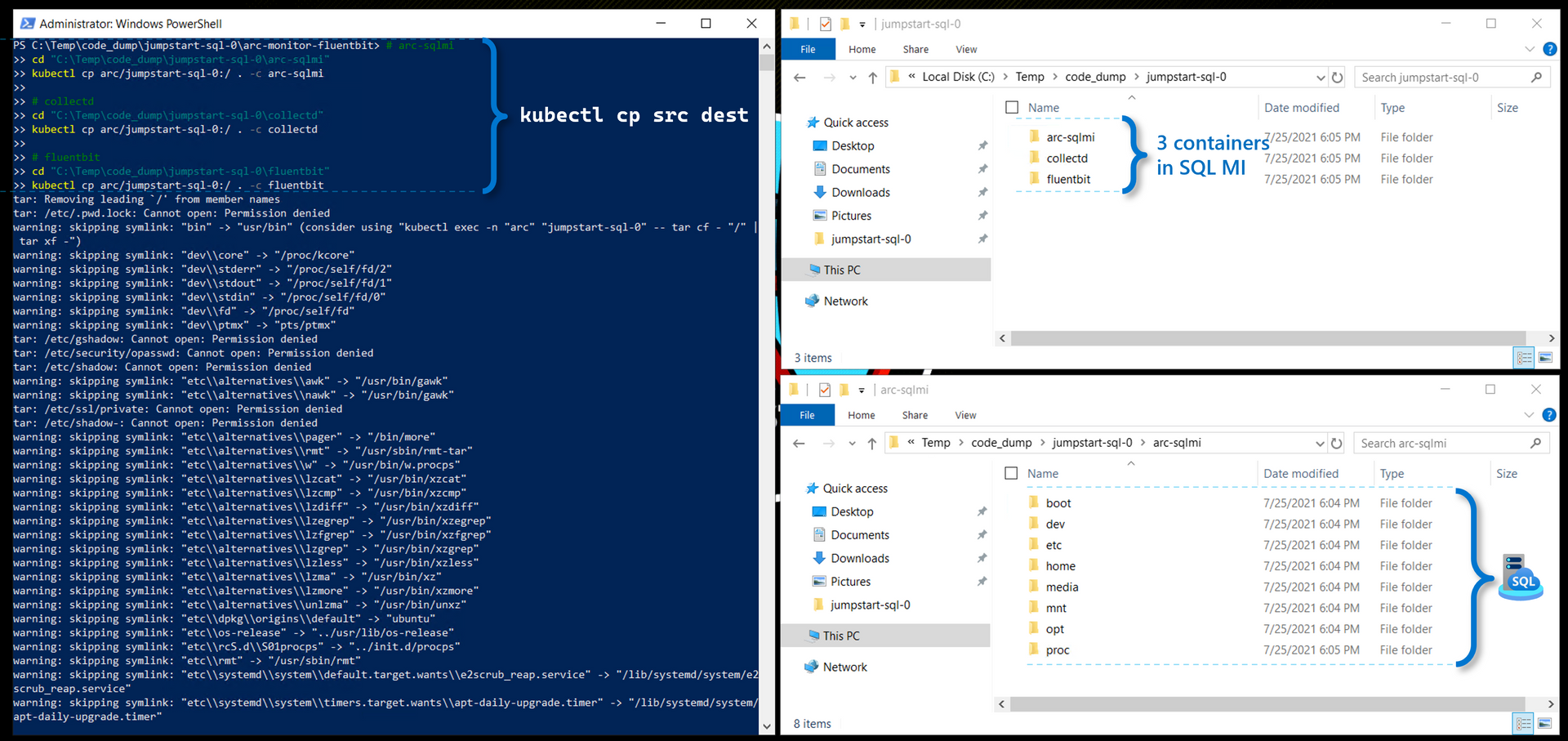
Comparing Arc Fluentbit image with generic
To close off, let's validate this reverse engineering method against the Dockerfile for another container such as Fluentbit which uses a distroless base image from gcr with GCC available, and compare the MCR image against the Dockerhub version:
# Fluentbit from Arc via MCR
dfimage -sV=1.36 mcr.microsoft.com/azurearck8s/fluent-bit:1.3.8 | grep -Pzo '.*Dockerfile(.*\n)*'
# Fluentbit from Dockerhub
dfimage -sV=1.36 fluent/fluent-bit:1.3.8 | grep -Pzo '.*Dockerfile(.*\n)*'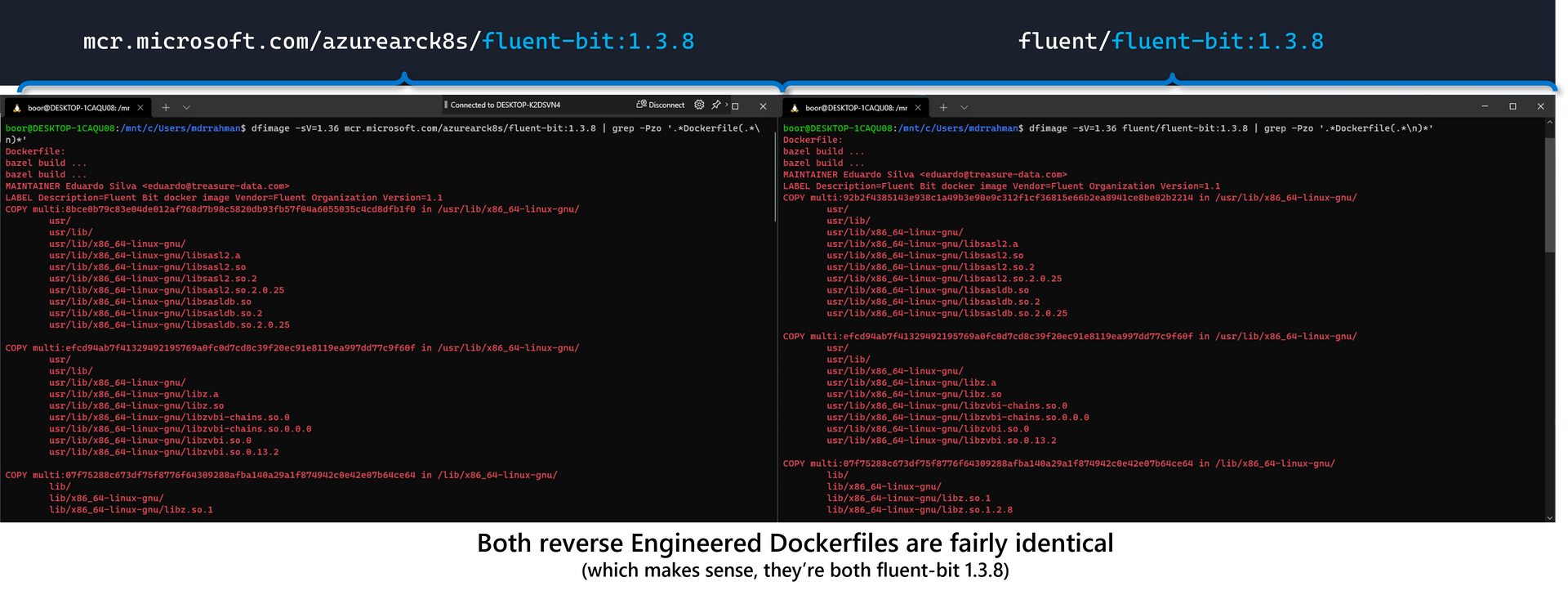
And since we have access to the fluent-bit 1.3.8 Dockerfile from the public repo, we can see that it's identical to our Reverse Engineered file:
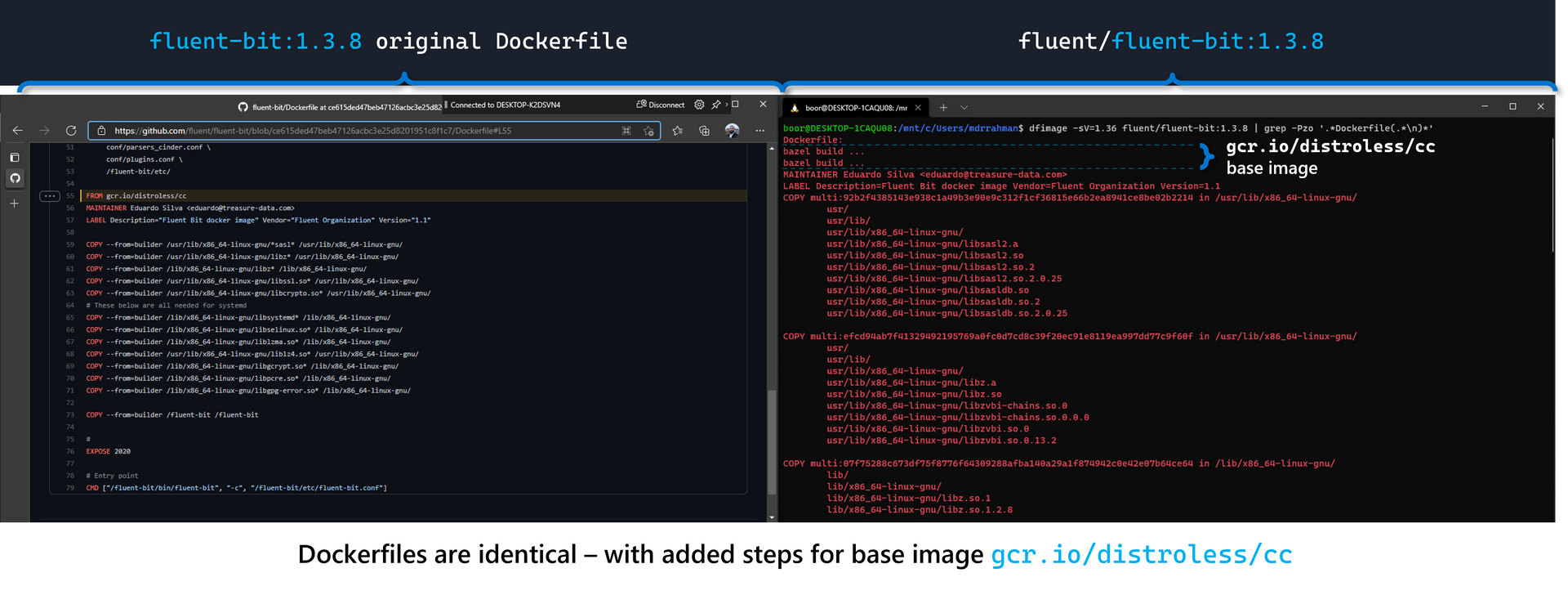
Summary
I've found the Dockerfile reverse engineering technique using Whaler to be fairly robust.
Regarding binary extraction, YMMV with running kubectl cp against restricted files running inside the Pod, as I ran into Permission Denied messages, and faced issues with kubectl cp failing on symlinks.
Happy sleuthing 🕵️♀️!